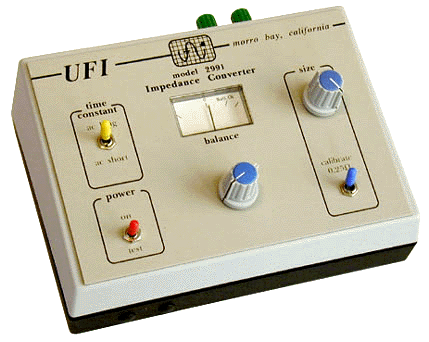UFI Model 2991
Impedance Converter

Measurement of the electrical signals that accompany many biological events is often difficult. Measurement problems stem mainly from very low signal amplitudes, high source impedances, or vulnerability to power line interference.
The Model 2991 Impedance Converter provides a way around many of these difficulties. Instead of trying to measure very small voltage changes, the Model 2991 measures the correlated impedance changes. These can range from 0.2 ohm for an impedance cardiograph to over 5 ohms for impedance respiration. Whether impedance changes are due to resistance, capacitance, or inductance variations, or more usually, a combination of these, the Model 2991 simply converts these impedance changes into a DC voltage. Many preparations can be instrumented directly. And this technical note discusses several novel ways to use physical transducers with the Model 2991.
Our 2991 has been used extensively for instrumenting aquatic life. But feel free to think ouside the box. In many respects, our 2991 is truly a universal signal conditioner!
Model 2991 specifications
- Electrodes: Depends on actual target measurement -- standard Ag-AgCl electrodes, needle electrodes, etc.
- Input connectors: 5-way binding posts
- Excitation frequency: ~75 kHz
- Front-end offset correction: 10-turn balance control
- Typical input impedance range: 1 to 2000 ohms
- Noise level: generally less than 5 millivolts peak-to-peak
- Signal Centering Display: Analog meter
- Output impedance: 4000 ohms typical
- DC output level for 0.25% impedance change: typically 250 millivolts
- AC output level for 0.25% impedance change: typically 2 volts
- Output connectors: Two BNC, one for DC, one for AC
- Power supply: 9V battery with built-in test
- Plastic case size: 2.5" x 5" x 7" (64mm x 127mm x 178mm)
- Weight: 16 ounces (450g)
- Options: 2991-EKG includes an EKG filter and amplifier to provide respiration and EKG from the same two electrodes -- contact UFI

